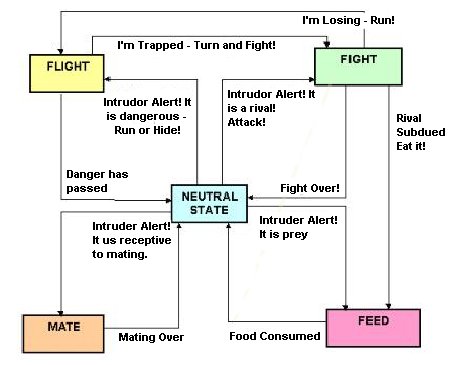Do Cats Have Emotions?

Recent studies, especially in fields such as neuropsychology, show that the more "primitive" or basic emotions have a physiological basis and may be caused by chemical stimuli (such as sexual attractant scents called pheromones) or visual stimuli. Basic emotions appear to cause chemical changes in the body in response to a stimulus. This article looks at feline feelings. In places it compares or contrasts human and feline responses or makes references to other animals for illustrative purposes.
Two Polarized Views
According to many pet owners, the answer is "yes". Cats display a range of feelings including pleasure, frustration and affection. Other feline behavior is attributed to jealousy, frustration and even vengefulness. Owners base their answer on observation of feline behavior, but without an understanding of what makes a cat tick, they risk crediting a cat with emotions it does not feel as well as recognizing genuine feline emotions. Owners who veer too far into the "Did my ickle-wickle fluffy-wuffikins miss his mummy then?" approach may not understand (or not want to accept) that a cat’s emotions evolved to suit very different situations to our own.
Cats and humans are built much the same way and share many of the senses – sight, hearing, smell, taste, touch – as well as having additional "senses" which are adaptations to our particular environments and lifestyles (e.g. the Flehmen taste-smell reaction in cats). Though humans have better vision, cats have better smell, taste and hearing. Like us, cats feel heat, cold, pain and other physical sensations. Physical stimuli may lead to physiological responses, some of which are termed emotions. If humans and cats have similar responses to, for example, the smell of enticing food, they may share certain emotions e.g. happiness at the prospect of a satisfying meal.
According to many scientists, however, the answer is "no". they argue that humans like to anthropomorphise animals, regarding pets as surrogate children. We interpret their instinctive behaviors according to our own wide range of emotions. We credit them with feelings they do not have. Some scientists deny that animals, including cats and dogs, are anything more than flesh-and-blood "machines" programmed for survival and reproduction. Others credit animals with some degree of emotional response.
Those who deny animals any feelings at all may do so in order to justify animal experiments which others consider inhumane. This denial of animal emotions allows them to conduct experiments with little regard for their subjects’ physical or mental well-being. The denial of animal emotions is their own hidden agenda rather than a conclusion based on study of behavior. Are either of these polarized views correct or do cats also share certain emotions, perhaps a limited subset of the emotions we feel? To find out, we must observe our own and our cats’ responses to situations and analyze what an emotion is.
In the Lab and in the Field
Laboratory animals and animals in a wild (or domestic) environment behave differently. They have different surroundings. Their interaction with other animals and with humans are very different. Laboratory animals may have little opportunity for social contact with others or their responses may have been impaired through experimentation or genetics . Some animals are selectively bred for specific traits and they may not exhibit "typical" or representative behavior.
Emotions cannot exist in a vacuum – they are (in part) a response to external factors. Many laboratory animals show aberrant behavior (e.g. self-mutilation, feces-eating) due to their sterile environment. These are signs of stress and depression, but are often not termed as such for reasons mentioned earlier. It is recognized that animals suffer in these conditions, for example animals in some of the worst zoos show behavioral/emotional problems: repetitive pacing/rocking and psychological problems.
Animals respond to their environment. It is not possible to accurately assess the normal psychological responses of a creature which is treated as an unfeeling biological machine and kept in an unstimulating or highly abnormal environment. This is just as dangerous as anthropomorphising animals in a cutesy fashion. Animal rights/animal welfare campaigners are often accused of inappropriately attributing emotions to animals. To recognize animal emotions would cause problems for experimental laboratories who do not wish to make potentially expensive changes to the environment in which their disposable living "tools" are stored.
Scientific methods do not like to have too many variables. Scientists prefer to measure one variable at a time. Unlike inanimate properties such as temperature or pressure which are individually controllable in laboratory conditions, emotions cannot be isolated. Environmental factors must be manipulated in order to produce an emotional change. Individuals may react in different ways to the same environmental change. This makes the study of emotions in laboratory conditions frustrating.
To properly assess animal emotions, scientists and animal behaviorists must study animals in the field or in the home. The environment can be manipulated, but cannot be controlled absolutely. What is important is how the animal behaves in its own environment and how it interacts with its environment and with others. The observer must interpret the behavior and decide whether the subject is fearful, apprehensive, angry etc. To ensure a consistent approach, the animal’s behavior may classified according to a shortlist of likely emotions or on a sliding scale for a particular attribute e.g. fearfulness or curiousness. Similar methods are used in assessing the behavior of very young children.
A growing number of farmers, particularly those in the organic sector, are recognizing the need for animals to express instinctive behaviors. Although some stress is unavoidable in farming, animals which suffer minimal stress may be more productive, have better immune systems, be less prone to disease and have a lower mortality (wastage) rate. This is even more apparent in zoos and wildlife parks where environmental enrichment and encouragement of natural behavior has led to "happier" (less stressed) animals more likely to breed successfully in captivity.
The Four Basic Behaviors
Animal behaviorists recognize four basic behaviors which are found in most animals. These are termed "The Four Fs". These are the four basic instinctive responses which aid survival:
- Fight
- Flight (or hide)
- Feed (predation or foraging)
- F*** (mate or reproduce) – the crudity helps psychologists with the mnemonic

The hormone adrenaline is a key player in these reactions. On encountering someone or something, the most immediate instinct is "Do I run away from it or stay and fight it?". This is a self-preservation reaction. If neither of those reactions is triggered, the next instinct is "Do I eat it? Do I mate with it?". If none of the 4 Fs apply the animal may exhibit curiosity or simply ignores the stimulus as irrelevant.
These behaviors can be modified through learning or conditioning. Cats will often ignore one another to avoid conflict. A cat raised alongside a rabbit may no longer have a "feed" response to that particular rabbit or to all rabbits. Pavlov demonstrated conditioning (learning) in his famous experiments where dogs were taught to associate a sound with the presentation of food. After a while, the dogs reacted to the sound even when food was not presented.
In humans, and probably in cats, these responses have two parallel routes through the brain. The "quick and dirty" route gives an instinctive, almost instant reaction. The "thinking" route takes slightly longer and modifies the animal’s reaction. Learning affects the thinking route. For example most animals will bolt (flight reaction) at a loud noise close by; gundogs and police horses are trained to stand their ground though they may still show instinctive startlement. Four basic responses are sufficient for primitive animals. Humans, cats, dogs and other more advanced animals need more than four basic instincts if they are to cope with a rich and varied environment. A complex environment requires a greater complexity of response.
The Six Basic Responses
In humans, there are 6 basic responses i.e. emotions which are rooted in our physiology. These cause an instinctive response in our brains and bodies, not just in our minds. These emotions are linked to particular brain areas in humans or to hormonal or chemical responses. They are survival responses to protect us from adverse conditions and to make us seek out favorable conditions. Most are linked to our perception of comfort and discomfort. It is likely that cats have equivalent physiological responses to the same, or similar, stimuli.
Fear
A self-preservation instinct. Fear leads to alertness, caution and possibly to flight. It prepares the body for flight or defense. Fear is the recognition of a potential danger rather than the instinctive (and possible energy wasting) flight from potential (rather than actual) danger. Fear allows the animal to assess how real or immediate the danger is and to take appropriate action (flight, freeze, hide, disregard etc).
Disgust
In the human context, originally this prevented us from eating contaminated food or coming into contact with filth. In modern humans it is also applied to other stimuli (the thought of doing something, an image or a situation). It is an avoidance mechanism. In cats, whose livers are not good at dealing with toxins, the avoidance of stale food is probably caused by a similar mechanism. Cats rely on smell, taste and "disgust" to avoid tainted food.
Desire (Lust)
Associated with the basic mating urge without which we would not breed. Desire is associated with pheromones and body language; and causes chemical reactions in our own bodies when we experience it. It is associated with mate-seeking, assessment of a potential mate’s suitability and courtship behavior rather than just with copulation.
Sadness
A form of psychological discomfort experienced in non-ideal situations; it helps us to avoid non-ideal conditions. Humans have a wide range of sadness-emotions varying from grief, transient upsets and some forms of depression (a chemical disturbance in the brain) have symptoms like sadness. Cats exhibit depression in some situations and some cats have been reported as "inconsolable" when a close companion dies. Separation anxiety in cats and dogs may be partly due to the sadness mechanism.
Happiness
A form of psychological comfort/satisfaction experience. It helps us seek ideal conditions or repeat beneficial behaviors (eating, sex); chemical reactions are involved – feel-good chemicals are released in the brain. In cats it is most often seen as "contentment" and is also evident in cats and kittens during play. Play is a self-fulfilling behavior which produces "happiness" by release of feel-good chemicals.
Anger
A reaction to a non-ideal situation when we intend to fight; chemical reactions occur in the body as part of the fight or flight response. It can also result in displacement activities such as self-mutilation. Cats which are handled against their will exhibit obvious anger. Most vets are familiar with sheer feline fury though it is hard to distinguish "anger" from the "fight" reaction. "fight" is relatively transient; anger (a bad mood) does not pass so quickly (a cross cat will stay angry even when the stimulus is removed).
The feline sniff-and-sneer reaction is the Flehmen response to "taste-smell" something. A cat has an excellent sense of smell and can detect food which is stale or contains medication. Though the sneer looks like disgust (humans wrinkle their noses when disgusted), it is simply the way the cat’s mouth is set to pass scent molecules over the Jacobsen’s Organ. After flehming, the will take the appropriate response.
Cats show fear and lust in response to the appropriate sights, sounds and smells, but love requires a degree of abstraction which cats probably do not possess. Lust is the mating urge, love is the emotional baggage which surrounds and tempers that urge in most humans. Humans have a wider range of emotions and the emotions which we share with cats are more refined in the human species.
Frustration
Frustration is what happens when a basic emotion cannot be, or is not, fully expressed. It is generally viewed as an emotion in itself rather than a displacement of the initiating emotion.
The build-up of physiological effects demands some sort of outlet. In territorial animals and birds there may be displacement activities such as shrieking, stamping, tearing vegetation (humans may cry in frustration) etc. These give alternative outlets for pent up energy. Frustration is what we feel when we cannot fully express ourselves or when the situation makes full expression impossible, impractical or unsafe.
For a cat living in a human world there are many frustrations which it resolves as best it can. Many are resolved through modifying other behavior through the learning or conditioning process. Cats are highly adaptable but they retain many wild instincts which need to be expressed e.g. hunting, territoriality.
Frustration is often associated with a state of agitation or high emotion. Feline frustration is obvious when a cat watching prey from behind a window chatters its teeth. The teeth chattering is a frustrated form of the neck bit the cat would have used to kill the prey. A cat which has lost a fight to another cat may lash out at its owner or may flee from a familiar person.
The cat’s body is still full of adrenaline and primed for fight or flight. Any approach from even a familiar person may trigger a fear or fight response. Similarly, it may attack other cats in the household. Female cats with a frustrated maternal instinct may abduct and protect another cat’s kittens, other small animals or kitten-like inanimate objects such as slippers.
Cats are wild creatures at heart, designed and programmed for outdoor life. In modern indoor cats, an owner must provide a stimulating environment to reduce feline frustration. Playing provides an outlet for predatory behavior and produces satisfaction in return.
Other Basic Emotions
There are a number of other basic emotions which are recognized in humans and in cats. These produce physiological responses and are varying degrees of , or combinations of, the six basic emotions. These include (but are not limited to):
Stress
Stress results from continued unhappiness where there is no escape from the stimulus. It affects the immune system, reducing the immune response. Continued elevation of adrenaline adversely affects other organs. Different animals have different stress levels. Some cats are nervous and more easily stressed than others.
Depression
Also a form of continue unhappiness including unhappiness due to pain. The chemical effects in brain can lead to withdrawal to the point where the animal loses the will to live. Depression can override survival instincts.
Euphoria
It is hard to think of euphoria in cats unless you have witnessed the effect of catnip. Not all cats are susceptible to a catnip high, but those that are exhibit a sort of drugged euphoria due to its effect on the brain.
Abstract and Complex Emotions
At present, the more abstract emotions are believed to be human only. However, what we define as altruism, relief etc, may be our rationalization of a emotion or a mixture of one or more basic emotions.

When owners say their cats are jealous, they are trying to rationalize a feline emotion into human terms. Feline "jealousy" may be a response to any number of stimuli – the cat seeking to better its place in the household hierarchy or an opportunist or stronger cat competing for food or attention.
The cat does not rationalize it in terms of "I am jealous of the other cat" or "I covet what the other cat has"; its feelings will be more along the line of "I am stronger or fitter than the other cat, I deserve to be dominant cat around here." Cats are not as strictly hierarchical as dogs, but where several cats live in a single household, they will establish a pecking order.
Is kitty really being bloody-minded or mean (in the American sense of mean-spirited, in Britain "mean" means "miserly"!). Is he really sulking or punishing you? If you have been absent, your cat may take a while to become re-accustomed to your presence – your return has altered the hierarchy again and he is not certain of its own position until the owner-cat (a sort of cat-kitten) bond is re-established.
Is he punishing you? Very unlikely – that is a human interpretation of the cat’s actions. Sulking? That may be as good a description as any – he may avoid interacting with you until the household has settled down into a pattern of behavior again.
When the owner returns to a household, the cat can react in different ways to this trigger – look at it from the cat’s point of view:
| Fight or Flight Response | |
| Do I run away? | No. Unless I am a very nervous cat or my owner has unusual scents about him or makes unusual sounds. |
| Do I fight? | No. |
| Food or Mate Response | |
| Do I feed? | No, my owner is not a food item. |
| Do I mate with him/her? | No. I have been neutered and in any case, s/he doesn’t smell like a suitable mate for me. |
| Learned responses | |
| My surrogate parent/surrogate littermate has returned | I will greet enthusiastically with submissive actions (rolling on back) or play actions appropriate to my status as a kitten. |
| I am curious | I will investigate and greet him/her. Interpreted as "pleased to see me" by owner. |
| S/He is no threat, is not food and is not a mate. | No action is required so I shall do nothing. Interpreted as sulking/punishment by owner. |
Affection
Cats show obvious pleasure in company of a familiar person, often a modified cat/kitten relationship. The presence of a companion/caregiver (surrogate parent) produces happiness (a basic emotion).. In the domestic setting, most cats adopt a kitten role, allowing us to groom them, play with them and provide food and warmth. By demonstrating their happiness (which we term "affection") they reinforce the cat-owner bond and ensure a continued supply of companionship and care.
Mother cats show affection towards their kittens. This is part of maternal care. Male cats have been known to show affection to their mates and towards their own kittens – this is similar to the behavior of lions towards their own cubs (but not towards unrelated cubs)..
There is little doubt that most pet cats enjoy the company of their humans and give affection in return. Those who deny that cats can be affectionate should analyze exactly what it is that makes humans affectionate. The underlying causes of affection are actually very similar!
Grief
Cats are aware that a familiar person/cat is absent and may search for that person/cat. It may change an established hierarchy as well as being the absence of a familiar companion. It is not grief in the human term, but the sudden absence of something familiar is distressing to many cats. The absence of a familiar part of the environment causes sadness. The continued absence of that person or thing can lead to stress. In the context of a bereavement, this stress is termed grief.
As with affection, humans must analyze exactly what causes and sustains human grief before arguing that animals do not feel a comparable emotion. Grief is a reaction to the sudden absence of something or someone which caused happiness/satisfaction.
The major difference is that cats show grief for someone who has been a close companion while humans show grief for a distant relative or at the death of a public figure. Cats simply lack the abstraction (and the memory capacity) which allows humans to grieve for someone we have never met or who has been absent from our life for a prolonged period of time.
Comprehension of Death (Bereavement)
Cat appear to comprehend a state of someone not being alive – body temperature changes, smell changes etc. Whether they make the link between a corpse and someone previously alive is not certain, but many cats stop looking for an absent companion after being shown the body of a deceased companion. Therefore cats probably have some comprehension that something dead cannot become alive again. The display of grief in cats is due to the absence of someone familiar. In humans it is, in part, due to the realization that we will never see that person alive again i.e. to our understanding of the permanence of death.
Pleasure
Pleasure appears to be an abstracted form of happiness/satisfaction which persists after the original stimulus has gone or which is felt in anticipation of an event. In many contexts, pleasure is a synonym for happiness/satisfaction. Pleasure can also occur through memory and through anticipation.
Sense of Humor
This is a tricky topic. The "smile" on a cat’s face is due to conformation of its muzzle. A cat "smiles" with its eyes and with its tail. Observant owners soon learn to distinguish a cat’s "happy face" from its "sad face". Cats do not tell jokes (certainly not that we know off) but they do engage in clownish behavior. A cat can suspend its adult behavior and revert to kitten behavior.
Scientists used to believe that a cat playing with its own reflection in a mirror or with a TV image is unable to distinguish an image from reality. Many still think that way. Pet cats learn very early on that reflections and TV are "not real". This doesn’t stop them making use of them as play objects. Batting a moving object is instinctive. Batting a picture on a TV is a safe outlet for hunting behavior, but the cat doesn’t expect to catch the object (unless it has never encountered the TV before).
Inexperienced cats and kittens expect to find the reflection cat behind the mirror. When the image puffs its tail and hisses (albeit silently) back at them, they may become startled. After a few unsuccessful checks behind the mirror (and the lack of any scent of the "other cat"), they accept the image as a plaything. Even experienced cats will occasionally search behind a mirror or TV in case the pretend prey has emerged from it.
It doesn’t really expect to find anything, but it is always worthwhile checking just in case! Suspension of disbelief in this way is sometimes considered to be the feline sense of humor. It is an outlet for predatory behavior and it results in happiness. Whether it is genuinely humor is debatable.
Some of the play tactics are interpreted as a sense of humor e.g. jumping out of hiding at the owner or onto a cat companion. This is play and is practice of the cat’s ambush hunting technique rather than a practical joke. A cat which engages in clownish behavior has learnt that its behavior results in a reward from the owner – food, attention, physical contact etc. This reward leads to happiness/satisfaction for the cat, therefore the behavior is repeated. If it is a sense of humor, it is one which has been conditioned (albeit unwittingly) into the cat.
Embarrassment
At first this seems like another tricky abstract emotion. A cat which clumsily falls off a shelf and acts differently according to whether the owner is watching or whether the owner is believed to be out of sight is thought to be showing embarrassment.. Embarrassment in humans is associated with potential loss of face, loss of status or loss of respect (these are all related, but modified by culture and circumstances). The loss of status may be permanent or temporary.
A cat is not only a predator, it is also prey for larger animals. In addition it is programmed to fight other cats for its territory and for mates. If it shows any indication of weakness, it may be challenged by a younger or fitter rival and ousted from its territory.
For this reason, many cats hide signs of illness, injury and pain. A cat which has fallen off a shelf in plain sight will pretend the event has not happened i.e. that it has not shown any weakness. A human may make excuses for why a similar human mishap happened (the ledge was icy or slippery); this is simply a human way of saving face. Cats speak with their bodies and an "embarrassed" cat will most often sit down and wash nonchalantly – cat speak for "nothing has happened"!
Jealousy
"The cat will be jealous of the new baby and harm it!" "My cat is jealous of the kitten and keeps urinating on the bed!" "Tiddles sulked and moved next door."
Jealousy and sulking are human emotions. A cat is protective of its territory and defends it. Unless a newcomer is carefully introduced so that it is accepted as a "family member", a territorial fight/flight response is triggered. Few cats respond to a new arrival with enthusiasm. We must understand how a cat views the world about it and to understand how it is responding rather than interpreting feline reactions as human-like emotions.
When a newcomer arrives, the owner’s attention is suddenly divided. The cat receives less attention. The newcomer may receive a disproportionate amount of attention. There are new smells and sounds and a bewildering change in routine and environment. Its relationship with the owner changes. Things become unfamiliar or stressful and the cat may become unhappy or depressed.
Urination on the bed (or elsewhere) is an attempt to scent mark territory in an attempt to repel an intruder. By mixing its scent with the owner’s scent, the cat is saying "My clan own this territory". When a child gets scratched it is rarely an attack by the cat. Most often the child (who is unable to read cat body language) has made a "threatening" move (grabbing fur, pulling tail) and the cat has responded to the perceived threat. After one or two such encounters the cat usually gives the child a wide berth until the child learns to behave more considerately.
The owner’s reaction confuses the cat. The child has molested it. The cat has swatted the child. The child cries. The parent consoles the child and chastises the cat. The child’s behavior is reinforced; the cat’s behavior is punished. In feline terms, the newcomer is ousting the cat from its territory. The "defeated" cat may remove itself from the situation; this is interpreted as sulking or the result of jealousy.
Some parents are so over-protective that a curious cat which sniffs a baby is interpreted as a jealous cat about to attack. With a little consideration for feline behavior and emotions, introductions can be managed carefully to avoid these cat/human misunderstandings. Cats respond to the situation according to their more limited range of emotions; jealousy and vengefulness are human, not feline, emotions.
So, Do They Have feelings?
Cats and other animals have feelings. However their feelings must be interpreted in the context of their own physical needs and their own environment. They have a more limited range of feelings than humans and their reaction to environmental stimuli is different to humans, but they show many responses indicative of emotions. Although I have used the term "programmed", to reduce cats to little more than pre-programmed machines with a finite set of available reactions would be wrong.
Those who deny that cats, or other animals, are entirely lacking in feelings do this to justify their own treatment of animals rather than through any true understanding of those animals. Rather than attribute full human feelings to cats, it is better to understand how cats perceive the world and to adjust our behavior to accommodate their physical and emotional needs as best we can.













